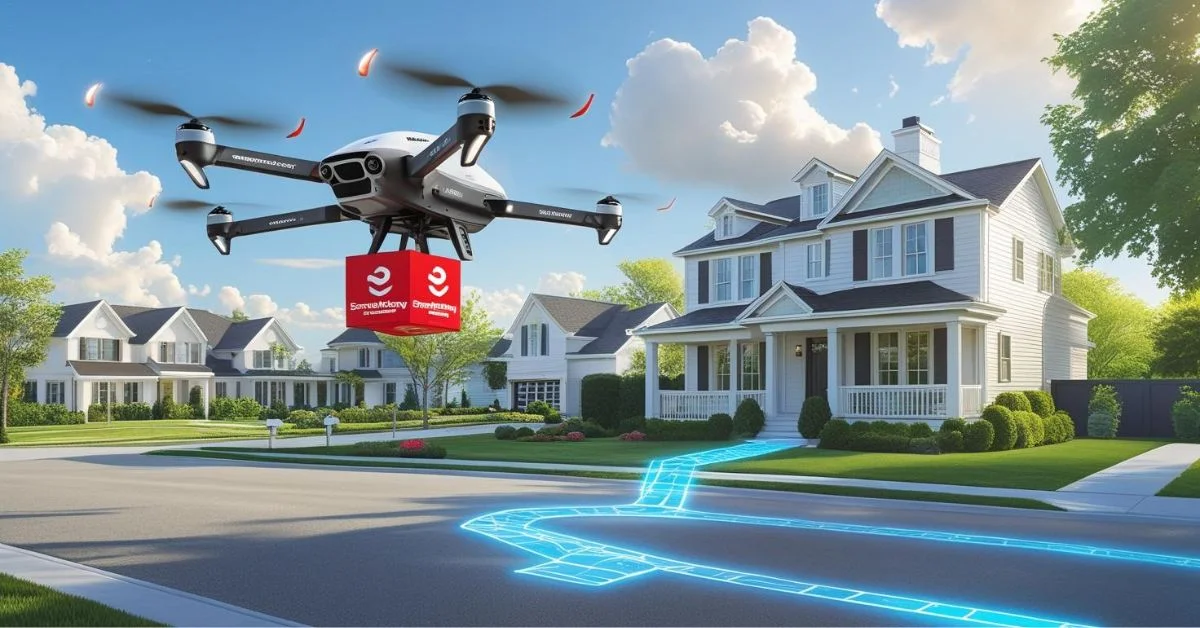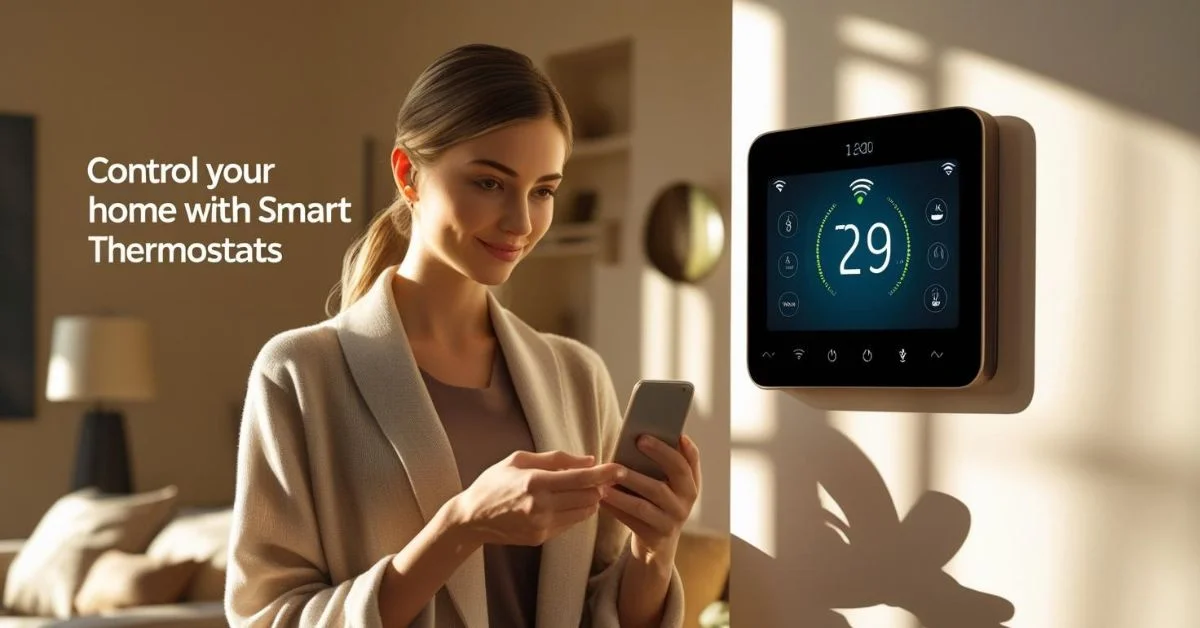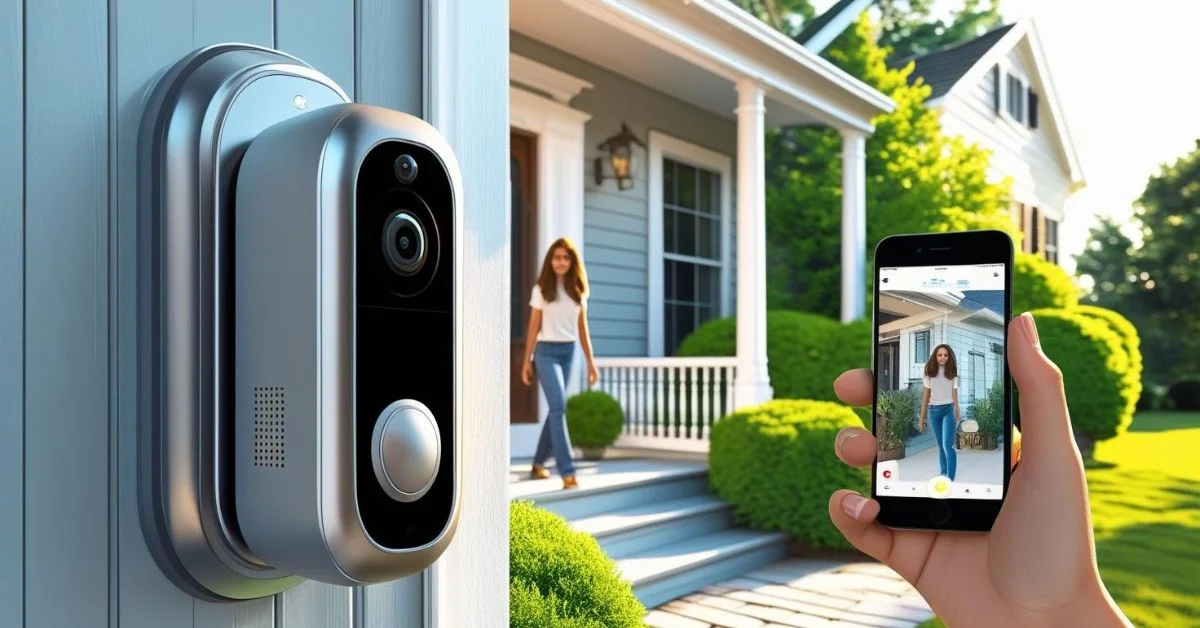The way we receive goods is changing faster than ever. One of the most exciting developments is drone delivery technology. Something that once felt like a futuristic fantasy is now becoming a regular part of modern life. From getting your groceries dropped off in your backyard to receiving urgent medical supplies in remote villages, drones are quickly becoming the future of delivery.
What Is Drone Delivery Technology?
Drone delivery technology uses small unmanned aerial vehicles (UAVs), commonly known as drones, to transport goods to a specific destination. These drones are usually powered by electricity and are programmed to fly automatically or be operated remotely by a pilot. They rely on GPS, cameras, sensors and sometimes artificial intelligence to navigate and drop off items safely.
Drones vary in size and capability. Some are designed for lightweight items like medicine or meals, while others can carry larger packages for longer distances. What sets drone delivery apart from traditional methods is its speed, efficiency and the ability to reach places that are difficult or expensive to access by road.
Why Drone Delivery Technology Matters?
Drone delivery is not just a fun or futuristic idea; it’s solving real-world problems and changing industries. Here are some key reasons why it’s gaining momentum:
- Faster Delivery Times: Drones avoid traffic and take the shortest route possible, cutting down delivery times from hours to just minutes.
- Better Access to Remote Areas: Drones can fly over mountains, rivers and poorly built roads to reach rural and hard-to-access locations.
- Eco-Friendly Operations: Most drones are electric, reducing greenhouse gas emissions and helping fight climate change.
- Cost Efficiency Over Time: Though the initial investment is high, drones can reduce long-term delivery costs by cutting fuel use and reducing labor.
- Emergency Use Cases: In disaster zones or during medical emergencies, drones can deliver life-saving supplies when other methods fail.
How Drone Delivery Works?
At a glance, drone delivery might seem simple, but the process behind it involves cutting-edge technology and strict protocols. Here’s how a typical drone delivery works:
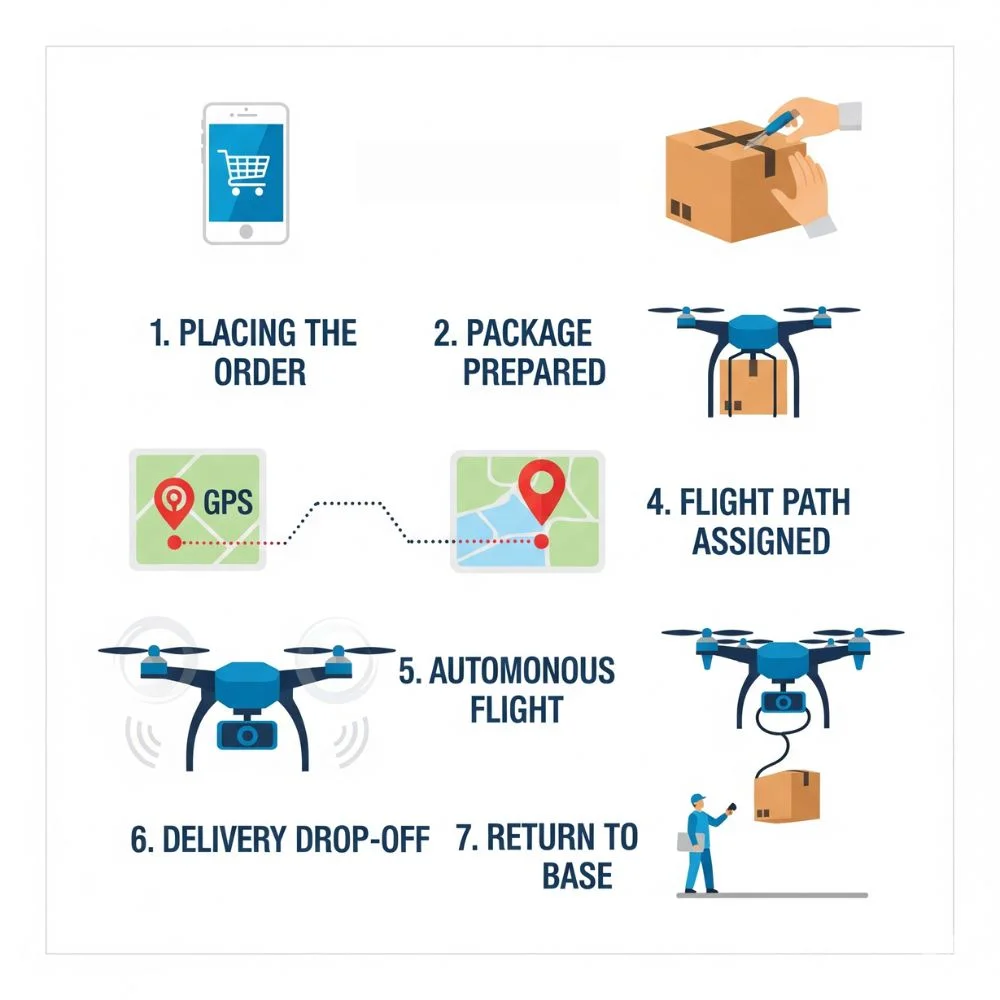
- Placing the Order: The process begins when a customer places an order through an online platform or mobile application.
- Package Prepared: The item is packed securely in a drone-compatible container.
- Drone Loaded: The package is attached to a drone at a launch station.
- Flight Path Assigned: The drone is programmed with GPS coordinates and route data.
- Autonomous Flight: The drone takes off and flies directly to the delivery address using pre-set paths.
- Delivery Drop-Off: Depending on the system, the drone either lands and releases the package or lowers it with a winch to the ground.
- Return to Base: The drone flies back to its hub for recharging or another delivery.
Today’s delivery drones come with obstacle-detection sensors, built-in navigation cameras and emergency backup systems to ensure safe and reliable operation. Many also have geofencing capabilities to prevent them from flying into restricted zones like airports or government buildings.
Where Is Drone Delivery Technology Being Used?
Drone delivery is already active in several industries and countries. Let’s take a closer look at some real-world applications and locations:
1. Retail and E-Commerce
Major companies like Amazon, Walmart and Alibaba are testing or rolling out drone deliveries in selected regions. Amazon’s Prime Air aims to deliver items in under 30 minutes. In China, Alibaba’s logistics arm has tested drone deliveries in rural areas.
2. Healthcare and Medical Services
One of the most impactful uses of drone delivery technology is in healthcare. A company called Zipline is already delivering blood, vaccines, and medications to hospitals in Rwanda, Ghana and the United States. These medical drones operate even in extreme weather and fly long distances across challenging terrain.
3. Food and Grocery Delivery
Drones are also changing how we order food. Companies like Flytrex and Manna are working with fast food chains and supermarkets to deliver meals, snacks and daily essentials directly to customers’ homes or designated pickup spots.
4. Postal Services and Logistics
Government postal services, such as Australia Post and the UK’s Royal Mail, are experimenting with drone delivery to transport letters and parcels across islands and rural communities. These drones are especially useful in areas where regular postal trucks can’t go efficiently.
How Drone Delivery is Helping in Disaster Response?
One of the most powerful and inspiring uses of drone delivery technology is in disaster relief and emergency response. When roads are damaged by earthquakes, floods or hurricanes, delivering essential supplies becomes a life-or-death challenge. In these situations, drones can literally become lifesavers.
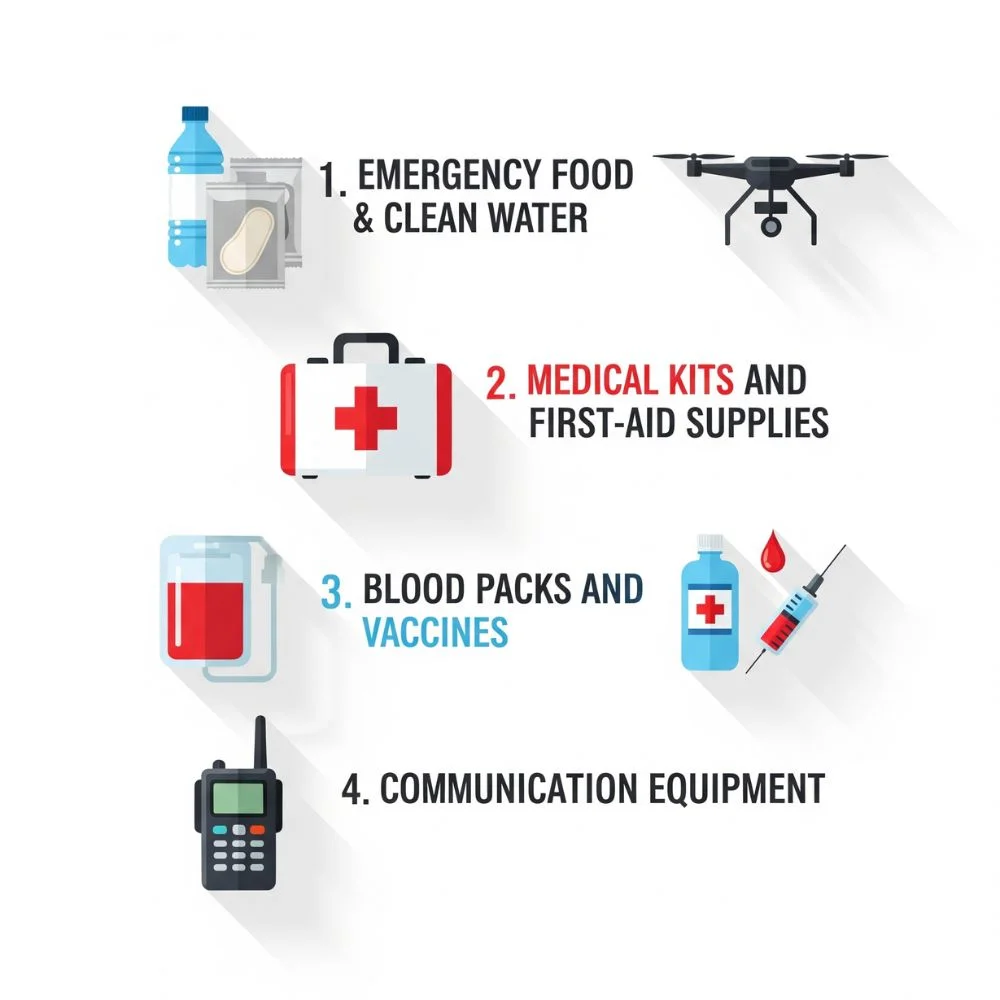
For example, in areas hit by natural disasters, drones can fly over blocked or broken roads to deliver:
- Emergency food and clean water
- Medical kits and first-aid supplies
- Blood packs and vaccines
- Communication equipment
These deliveries are often made within minutes, reaching people who would otherwise be cut off from help. The speed and agility of drones make them ideal for such critical missions. Organizations like the United Nations, Red Cross and Doctors Without Borders have all started using drones for disaster response.
In 2023, during wildfires in California and floods in Bangladesh, drone deliveries helped thousands by bringing relief items faster than traditional vehicles. With climate change causing more frequent extreme weather events, the use of drones in humanitarian aid is expected to grow rapidly.
For governments and NGOs, investing in drone delivery technology isn’t just a matter of convenience, it’s about saving lives in the most urgent situations.
Who Are the Leaders in Drone Delivery Technology?
The global race to master drone delivery is being led by a mix of tech giants, startups and logistics providers. Some of the key players include:
- Amazon Prime Air: Focused on ultra-fast home delivery in the U.S. and Europe.
- Zipline: Specializing in medical deliveries in Africa and the U.S.
- Wing (by Alphabet): Offering drone delivery for food, medicine, and small packages.
- UPS Flight Forward: Focused on healthcare deliveries in urban areas.
- Flytrex: Delivering restaurant meals in the U.S. suburbs.
- Manna, an Irish-based company, specializes in delivering groceries and freshly prepared meals using specially designed, low-noise drones.
These companies are not only delivering goods but also working with governments to help shape drone flight regulations and build safe, scalable systems.
The Technology Behind the Scenes
Behind every successful drone delivery is a blend of hardware and software working together:
- GPS Navigation: Drones rely on precise GPS systems to reach the exact destination.
- Artificial intelligence and machine learning help drones analyze past flight data to enhance route planning and delivery accuracy.
- Obstacle Detection: Cameras and infrared sensors help drones avoid birds, buildings, trees and power lines.
- Advanced Batteries: Lithium-ion and solar-powered batteries are improving flight range and durability.
- Cloud-Based Software: Real-time tracking and fleet management tools help operators monitor multiple drones at once.
- Air Traffic Integration: New systems are being developed to safely integrate drones into controlled airspace, just like airplanes.
Benefits of Drone Delivery for Businesses and Customers
For businesses and consumers, the advantages are significant:
- Faster customer satisfaction: Orders arrive within minutes.
- Reduced last-mile costs: Businesses spend less on local delivery drivers and gas.
- Increased accessibility: Customers in rural or disaster-prone areas receive goods quickly.
- 24/7 delivery potential: Drones can operate even at night or during off-hours.
- Eco-Friendly Operation: Battery-powered drones generate fewer emissions and consume less energy, making them a greener delivery option.
Challenges Still Facing Drone Delivery
Even though drone delivery technology has come a long way, there are still some major hurdles to overcome:
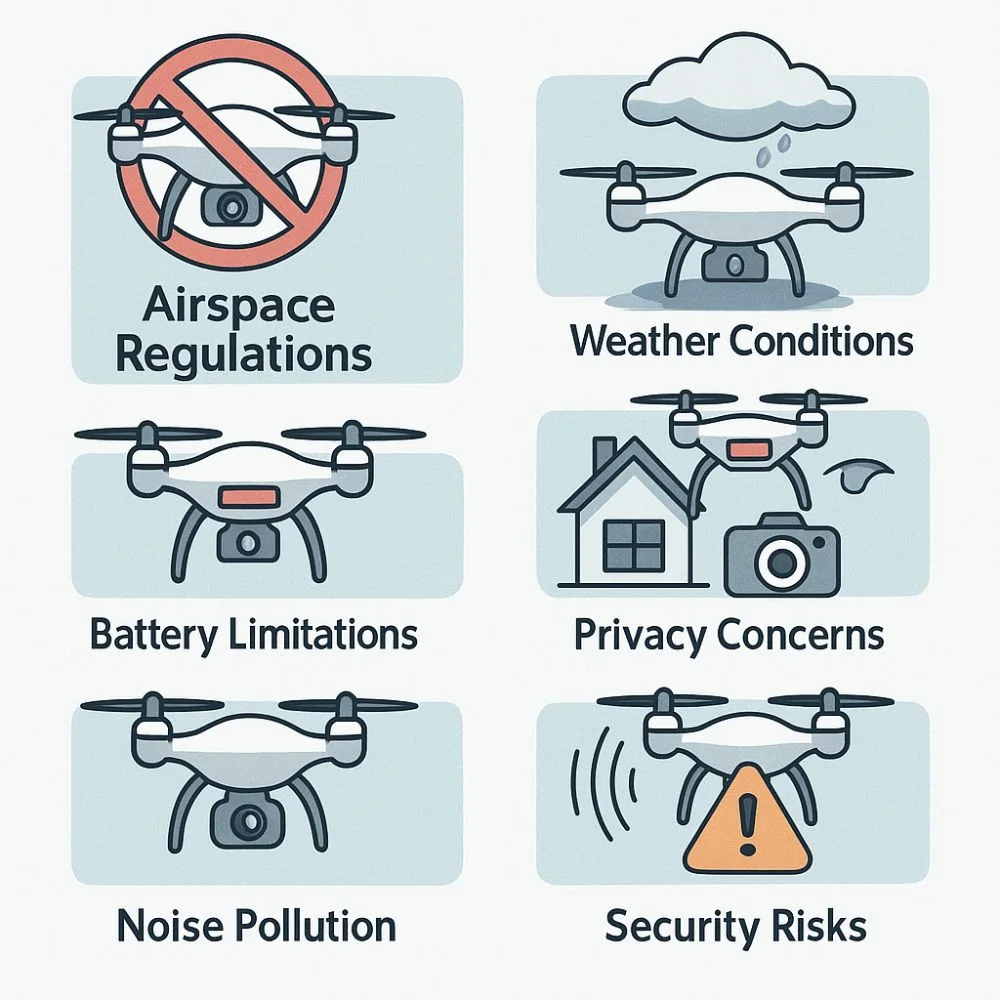
- Airspace Regulations: Countries have different rules about where and how drones can fly. In many areas, flying beyond visual line of sight (BVLOS) is restricted.
- Weather Conditions: Strong winds, rain and snow can ground drones and delay deliveries.
- Battery Limitations: Most commercial drones can only fly for 20–45 minutes before needing to recharge.
- Privacy Concerns: People worry about drones flying over private property and collecting video data.
- Noise Pollution: Though quieter than helicopters, some drones still make noticeable buzzing sounds.
- Security Risks: There are concerns about drones being hacked or used for illegal purposes.
Governments and companies are working together to address these issues and develop safe, effective drone delivery systems.
What Drone Delivery Means for the Job Market?
While many people are excited about the speed and efficiency of drone deliveries, others worry about how it might affect jobs, especially for drivers and delivery workers. It’s true that automation and robotics are changing the job landscape, but drone technology is also creating new kinds of employment opportunities.
Here’s how the job market is evolving alongside drone delivery:
1. New Careers Emerging
- Drone operators and pilots: People trained to manage and supervise drone flights.
- Drone maintenance technicians: Professionals who inspect, repair, and upgrade drones.
- Air traffic safety analysts: Experts who help integrate drones safely into urban skies.
- Delivery logistics planners: People who optimize drone delivery routes and times.
- Drone software developers: Engineers who design and improve navigation and delivery software.
As businesses scale up drone operations, they will need skilled workers to operate and manage fleets, troubleshoot technical issues, ensure safety compliance and analyze performance data.
2. Upskilling Opportunities
Several companies and institutions are now providing training opportunities to help employees gain the skills needed for emerging roles in drone logistics and tech support. For example, delivery drivers can receive certifications to become drone coordinators or support staff in drone hubs.
So instead of replacing humans, drone delivery technology is shifting the demand toward higher-skilled, tech-based roles. With the right education and support, the technology can empower workers instead of leaving them behind.
The Future of Drone Delivery Technology
In the near future, drone-based delivery services are likely to become a common convenience in everyday life for people around the world. Here are some trends to watch:
- Urban Drone Ports: Rooftop drone hubs in cities will allow for more deliveries in crowded areas.
- Heavier Payloads: Future drones may carry up to 20kg or more, expanding what can be delivered.
- Personal Drones: Individuals may soon use personal drones to send small items across town.
- AI Automation: Smarter drones will make decisions in real time to avoid hazards and reroute during weather delays.
- Sustainable Designs: Eco-friendly materials and quieter motors will make drones even more community friendly.
- Full Integration with E-Commerce: Online shops will offer drone delivery as a standard option, just like home or locker pickup today.
Final Thoughts
Drone delivery technology is transforming how we receive goods, especially in industries like e-commerce, healthcare and food service. It’s fast, efficient, environmentally friendly and becoming more accessible every year. With major players investing in smarter systems and governments opening up airspace, the skies are about to get a lot busier.
Companies that embrace drone delivery early on can gain a significant edge over competitors by offering faster, more efficient service. For customers, it means shorter wait times and better service. With rapid advancements in technology, the widespread adoption of drone delivery seems more promising and imminent than ever before.
